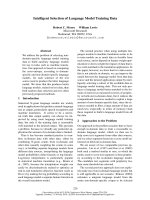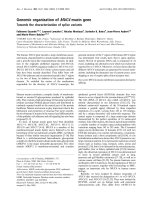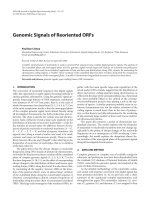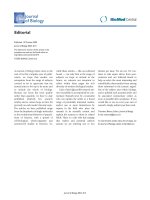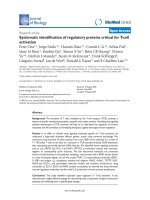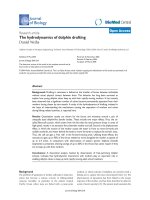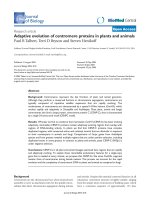Báo cáo sinh học: " Genomic selection of purebreds for crossbred performance" pps
Bạn đang xem bản rút gọn của tài liệu. Xem và tải ngay bản đầy đủ của tài liệu tại đây (283.73 KB, 10 trang )
BioMed Central
Page 1 of 10
(page number not for citation purposes)
Genetics Selection Evolution
Open Access
Research
Genomic selection of purebreds for crossbred performance
Noelia Ibánẽz-Escriche
1
, Rohan L Fernando
2
, Ali Toosi
2
and
Jack CM Dekkers*
2
Address:
1
Genètica i Millora Animal- Centre IRTA Lleida, 25198 Lleida, Spain and
2
Department of Animal Science, Iowa State University, Ames
50011-3150, USA
Email: Noelia Ibánẽz-Escriche - ; Rohan L Fernando - ; Ali Toosi - ;
Jack CM Dekkers* -
* Corresponding author
Abstract
Background: One of the main limitations of many livestock breeding programs is that selection is
in pure breeds housed in high-health environments but the aim is to improve crossbred
performance under field conditions. Genomic selection (GS) using high-density genotyping could
be used to address this. However in crossbred populations, 1) effects of SNPs may be breed
specific, and 2) linkage disequilibrium may not be restricted to markers that are tightly linked to the
QTL. In this study we apply GS to select for commercial crossbred performance and compare a
model with breed-specific effects of SNP alleles (BSAM) to a model where SNP effects are assumed
the same across breeds (ASGM). The impact of breed relatedness (generations since separation),
size of the population used for training, and marker density were evaluated. Trait phenotype was
controlled by 30 QTL and had a heritability of 0.30 for crossbred individuals. A Bayesian method
(Bayes-B) was used to estimate the SNP effects in the crossbred training population and the
accuracy of resulting GS breeding values for commercial crossbred performance was validated in
the purebred population.
Results: Results demonstrate that crossbred data can be used to evaluate purebreds for
commercial crossbred performance. Accuracies based on crossbred data were generally not much
lower than accuracies based on pure breed data and almost identical when the breeds crossed
were closely related breeds. The accuracy of both models (ASGM and BSAM) increased with
marker density and size of the training data. Accuracies of both models also tended to decrease
with increasing distance between breeds. However the effect of marker density, training data size
and distance between breeds differed between the two models. BSAM only performed better than
AGSM when the number of markers was small (500), the number of records used for training was
large (4000), and when breeds were distantly related or unrelated.
Conclusion: In conclusion, GS can be conducted in crossbred population and models that fit
breed-specific effects of SNP alleles may not be necessary, especially with high marker density. This
opens great opportunities for genetic improvement of purebreds for performance of their
crossbred descendents in the field, without the need to track pedigrees through the system.
Published: 15 January 2009
Genetics Selection Evolution 2009, 41:12 doi:10.1186/1297-9686-41-12
Received: 14 January 2009
Accepted: 15 January 2009
This article is available from: />© 2009 Ibánẽz-Escriche et al; licensee BioMed Central Ltd.
This is an Open Access article distributed under the terms of the Creative Commons Attribution License ( />),
which permits unrestricted use, distribution, and reproduction in any medium, provided the original work is properly cited.
Genetics Selection Evolution 2009, 41:12 />Page 2 of 10
(page number not for citation purposes)
Introduction
One of the main limitations of many livestock breeding
programs is that selection is in purebred nucleus lines or
breeds that are housed in high-health environments but
the goal of selection is to improve crossbred performance
under field conditions. Due to genetic differences
between purebreds and crossbreds and environmental
differences between nucleus and field conditions, per-
formance of purebred parents can be a poor predictor of
performance of their crossbred descendants [1]. Further-
more, some important traits such as disease resistance
cannot be measured in nucleus lines. In order to avoid
these problems, it has been proposed to select purebred
relatives based on crossbred performance using combined
crossbred and purebred selection or CCPS [2-6]. This
approach can increase response to selection for crossbred
performance relative to the classical method of selection
on purebred performance [7]. It has, however, not been
extensively implemented in livestock due mainly to the
difficulty and cost of routine collection of phenotypic and
pedigree data from crossbreds in the field [1]. In addition,
using CCPS increases the rate of inbreeding [8] and makes
it difficult to accommodate non-additive gene action [6].
As an alternative to CCPS, Dekkers [1] proposed to select
purebreds for commercial crossbred performance using
genomic selection.
In livestock, genomic selection is becoming increasingly
feasible because of the availability of massive numbers of
single nucleotide polymorphism (SNP) markers. This
approach consists of predicting breeding values on the
basis of a larger number of SNPs [9-11], utilizing linkage
disequilibrium (LD) between SNPs and the QTL.
Genomic selection of purebreds for crossbred perform-
ance involves estimating effects of SNPs on crossbred per-
formance, using phenotypes and SNP genotypes
evaluated on crossbreds, and applying the resulting esti-
mates to SNP genotypes obtained on purebreds (Dekkers
2007). Genomic selection for crossbred performance has
three main advantages over CCPS: 1) it does not require
pedigree information on crossbreds, 2) after estimates of
SNP effects are obtained using genotype and phenotype
data, prediction can continue for several generations with-
out additional phenotypes [9], 3) it reduces the rate of
inbreeding [12], and 4) it makes accommodating non-
additive gene action easier [1]. The success of genomic
selection depends mainly on the prediction accuracy of
the estimated breeding values (GEBVs). Several authors
have studied the accuracy of these predictions by compu-
ter simulation [9,13,14]. However, these studies have
focused on pure breeds. In crossbred populations, effects
of SNPs may be breed specific because the extent of LD
between SNPs and QTL can differ between breeds. More-
over, the LD may not be restricted to markers that are
tightly linked to the QTL. Both these problems could be
addressed by using a model with breed-specific effects of
SNP alleles. Toosi et al. [15] evaluated simulated training
populations consisting of crosses or mixtures of breeds
and found the accuracy of genomic selection to be lower
compared to using purebred data for training, but not by
a large degree. They, however, used a genomic selection
model in which SNP allele effects were assumed the same
in all breeds. Thus, the objective of this study was to com-
pare by computer simulation the accuracy of genomic
selection of purebreds for commercial crossbred perform-
ance, using either the classical genomic selection model
with across-breed effects of SNP genotypes (ASGM) or a
model with breed-specific effects of SNP alleles (BSAM).
Methods
Simulation
In all simulations, the genome consisted of one chromo-
some of 1 Morgan with 6000 SNPs and 30 biallelic QTL.
A gamma distribution with shape and scale parameters
equal to 0.4 and 1/1.66 was used to sample the absolute
value of effects of the QTL. The sign of the QTL effect was
sampled to be positive or negative with probability 0.5.
Effects were rescaled to result in a genetic variance equal
to 1.0. The phenotypic trait was simulated under additive
gene action. Dominance and epistatic effects were not
simulated but would be captured to the extent that they
are incorporated in allele substitution effects (see discus-
sion).
In the base population, SNP and QTL alleles were sam-
pled from a Bernoulli distribution with frequency 0.5. A
mutation rate of 2.5 × 10
-5
per generation was applied in
the following generations for all loci, where mutations
switched the allele state from 1 to 2 or from 2 to 1. Recom-
binations on a chromosome were modeled according to a
binomial map function [16].
Three scenarios for breed history were considered in this
study. In the first two scenarios, the breeds were assumed
to have a common origin either 50 or 550 generations
ago. In the third scenario, the breeds did not have a com-
mon origin. These scenarios will be referred to as having
closely related breeds, distantly related breeds, and unre-
lated breeds, respectively. In all cases LD was simulated by
drift and mutation in two periods. In the first period of
1000 generations, random mating was simulated in an
effective population of size 500. In the second period of
50 generations, random mating continued after reducing
the effective population size to 100. In generation 1051
the population size was expanded to 1000 or 4000 indi-
viduals simulating more matings and seven more genera-
tions of random mating with the expanded population
size were produced. Also, in generation 1051 three differ-
ent commercial crossbred lines were generated with 1000
or 4000 individuals. These crossbred lines were an AxB
Genetics Selection Evolution 2009, 41:12 />Page 3 of 10
(page number not for citation purposes)
two-breed cross, an ABxC three-breed cross, and an
ABxCD four-breed cross. The crossbred lines in generation
1051 were used for "training" with phenotype and geno-
type data, and the purebred lines in generation 1058 for
validation with only genotype data. Either 500 or 2000
segregating SNPs (minor allele frequency > 0.05) from the
crossbred population were chosen for analysis. Some of
these segregating SNPs in the crossbred populations were
fixed in the purebred populations. Heritability of the
quantitative trait was set to 0.3 by rescaling QTL effects in
the training population. The method to estimate SNP
effects was Bayes-B [9], which is described further in the
following. The criterion to compare models was the accu-
racy of estimated breeding values for the purebred valida-
tion population, calculated as the correlation between
true and estimated breeding values. Each simulated data
set and analysis was replicated 40 times.
Statistical Models
The statistical models used for the analyses are described
here. The across-breed SNP genotype model (ASGM) is:
where y
i
is the phenotype of i,
μ
is the overall mean, X
ij
(0,
1, or 2) is the genotype of i at marker locus j,
β
j
is the
across-breed allele substitution effect of locus j in the
training population,
δ
j
is a 0/1 indicator variable that spec-
ifies if locus j is included in the model or not, and e
i
is the
residual of i. The breed-specific SNP allele model (BSAM)
is:
where (0,1) is the SNP allele at locus j, of breed origin
k that i received from its sire, is the breed-specific sub-
stitution effect for allele . If the sire of i is a purebred,
k takes the same value for all alleles, e.g. k = 1 if the sire is
purebred A. On the other hand, if the sire is crossbred, AxB
for example, k can take values 1 or 2, indicating whether
the SNP allele received for the sire originated from breed
A or B.
The variable, , is a 0/1 indicator that specifies if the sire
allele is included in the model for locus j.
Similarly, , , and are defined for the SNP allele
at locus j, of origin l that i received from its dam. Breed ori-
gin of alleles was assumed to be known without error in
the analyses.
The Bayes-B method described by Meuwissen et al. [9] was
used to estimate the across-breed additive effects in ASGM
and the breed-specific additive effects in BSAM. The prior
probability for a locus to be included in the model was set
to 0.05, i.e., Pr(
δ
j
= 1) = 0.05. A previous study of prior
sensitivity was performed to validate that it did not influ-
ence in the model results. For loci in the model, the locus
effects were assumed to be normal with null mean and
locus specific variance in ASGM, and locus and
breed-origin specific variance and for BSAM.
Following Meuwissen et al. [9], the prior for these vari-
ance components was an inverse chi-square with 4.234
degrees of freedom and scale parameter S = 0.0429. The
prior for the was an inverse chi-square distribution
with four degrees of freedom and scale parameter S = 0.4,
and a flat prior was used for
μ
. A difference between the
Bayes-B implementation of Meuwissen et al. [9] and that
used here is that we fitted effects of SNP genotypes and
alleles rather than of haplotypes. After some exploratory
analyses, a single chain of 100,000 samples was used, with
a burn-in period of 1000. Convergence was tested for all
dispersion parameters separately using the Raftery and
Lewis [17] method and a visual check of the chain plots.
Results
Accuracy of prediction of breeding values in the purebred
lines using ASGM and BSAM are in Tables 1, 2 and 3.
Results when the AxB two-breed cross was used as training
population are in Table 1. In this table, the accuracy of
both models (ASGM and BSAM) increased with marker
density and size of the training data. Accuracies of both
models also tended to decrease with increasing distance
between breeds. The effect of marker density, training data
size and distance between breeds, however, differed
between the two models, which resulted in the model
with the highest accuracy to differ between scenarios.
Given the differences in marker-QTL LD, we would have
expected the model that fitted breed-specific SNP allele
effects (BSAM) to have greater accuracy. However, that
was the case only when the number of markers was small
(500), the number of records used for training was large
(4000), and when breeds were distantly related or unre-
lated. When the number of markers was increased to
2000, ASGM gave better results when breeds were closely
related, and the difference in accuracy was significant in
the simulation with 1000 records. For distant or unrelated
yXe
iijjji
j
=+ +
∑
μβδ
,
(1)
yAAe
iijk
S
jk
S
j
S
ijl
D
jl
D
j
D
i
j
=+ + +
∑
μβδβδ
(),
(2)
A
ijk
S
β
jk
S
A
ijk
S
δ
j
S
A
ijl
D
β
jl
D
δ
j
D
σ
β
j
2
σ
β
jk
S
2
σ
β
jl
D
2
σ
e
2
Genetics Selection Evolution 2009, 41:12 />Page 4 of 10
(page number not for citation purposes)
Table 1: Accuracy (se) of breeding values in pure breed predicted based on two-breed cross data using ASGM or BSAM for three
different scenarios (40 replicates)
closely related breeds distantly related breeds unrelated breeds
1000 records
Markers VP
a
ASGM BSAM Diff
b
ASGM BSAM Diff
b
ASGM BSAM Diff
a
500 B 0.78 0.79 -0.01 0.72 0.76 -0.04 0.72 0.73 - 0.02
(0.01) (0.02) (0.01) (0.05) (0.04) (0.02) (0.03) (0.03) (0.01)
2000 B 0.87 0.81 0.06 0.81 0.81 0.00 0.80 0.81 -0.01
(0.01) (0.01) (0.01) (0.01) (0.01) (0.01) (0.01) (0.01) (0.01)
4000 records
Markers VP
a
ASGM BSAM Diff
b
ASGM BSAM Diff
b
ASGM BSAM Diff
b
500 B 0.83 0.85 -0.02 0.78 0.82 -0.04 0.77 0.80 -0.03
(0.01) (0.01) (0.01) (0.02) (0.02) (0.01) (0.03) (0.03) (0.01)
2000 B 0.92 0.91 0.01 0.91 0.91 0.01 0.88 0.91 -0.03
(0.01) (0.01) (0.01) (0.01) (0.01) (0.01) (0.02) (0.02) (0.01)
a
Pure breed used as validation population.
b
Difference (se) of accuracy between ASGM and BSAM.
Table 2: Accuracy (se) of breeding values in pure breed predicted based on three-breed cross data using ASGM or BSAM for three
different scenarios (40 replicates)
closely related breeds distantly related breeds unrelated breeds
1000 records
Markers VP
a
ASGM BSAM Diff
b
ASGM BSAM Diff
b
ASGM BSAM Diff
b
500 B 0.68 0.63 0.05 0.57 0.59 -0.02 0.44 0.42 0.02
(0.02) (0.03) (0.02) (0.03) (0.04) (0.02) (0.03) (0.04) (0.03)
C 0.79 0.74 0.05 0.64 0.63 0.01 0.56 0.57 -0.02
(0.02) (0.02) (0.01) (0.03) (0.03) (0.01) (0.03) (0.03) (0.02)
2000 B 0.82 0.74 0.08 0.66 0.63 0.04 0.63 0.63 0.00
(0.02) (0.02) (0.01) (0.04) (0.04) (0.02) (0.02) (0.02) (0.01)
C 0.85 0.73 0.11 0.77 0.68 0.09 0.71 0.67 0.04
(0.03) (0.02) (0.02) (0.03) (0.02) (0.02) (0.02) (0.02) (0.01)
4000 records
Markers VP
a
ASGM BSAM Diff
b
ASGM BSAM Diff
b
ASGM BSAM Diff
b
500 B 0.79 0.81 -0.02 0.68 0.75 -0.07 0.63 0.71 -0.08
(0.02) (0.02) (0.01) (0.02) (0.03) (0.01) (0.03) (0.06) (0.03)
C 0.82 0.79 0.02 0.74 0.74 0.00 0.76 0.77 0.01
c (0.02) (0.02) (0.01) (0.03) (0.03) (0.01) (0.03) (0.03) (0.05)
2000 B 0.87 0.86 0.01 0.85 0.87 -0.02 0.79 0.67 0.11
(0.04) (0.01) (0.01) (0.02) (0.02) (0.01) (0.05) (0.04) (0.02)
C 0.92 0.86 0.06 0.83 0.80 0.03 0.79 0.72 0.06
(0.02) (0.01) (0.01) (0.02) (0.02) (0.01) (0.05) (0.04) (0.02)
a
Pure breed used as validation population.
b
Difference (se) of accuracy between ASGM and BSAM.
Genetics Selection Evolution 2009, 41:12 />Page 5 of 10
(page number not for citation purposes)
breeds, BSAM had accuracies that were equal to or better
than those with ASGM.
As a reference, accuracy of predicting breeding value in a
purebred line when training was in the same line is given
in Table 4. These results are almost identical to those in
Table 1 for closely related breeds.
Accuracies of the best model in the cross are, however,
lower for distant and unrelated breeds. Results when the
ABxC three-breed cross was used as the training popula-
tion are in Table 2. In this scenario, 50% of the alleles in
the training population are from breed C but only 25%
are from either breed A or B. Thus, accuracies are given in
this table for predicting breeding values of B and C pure-
bred animals. In all cases and for both models, accuracies
were lower for breed B than for breed C, as expected. Also,
general trends in accuracies for a given model with
changes in marker density, data size, and breed distance
were similar as observed for the two-way cross in Table 1.
The relative performance of the two models, however, dif-
fered from what was observed for the two-way cross. For
the three-way cross (Table 2), with closely related breeds,
ASGM gave better results when 1000 records were used,
and with the exception of predicting purebred B animals
using 500 markers, all these differences were significant.
For close breeds, when 4000 records were used for train-
ing, ASGM was significantly better only for predicting
purebred C animals using 2000 markers. For distant or
unrelated breeds, ASGM was significantly better than
BSAM for predicting purebred C animals using 2000
markers and 1000 records for training. When the number
of records for training was increased to 4000, BSAM was
significantly better for predicting purebred B animals
using 500 markers in scenario 2, but ASGM was better for
predicting purebred B animals using 500 markers in sce-
nario 3 and for predicting purebred C animals using 2000
markers in scenarios 2 and 3.
Results when the ABxCD four-breed cross was used as the
training population are in Table 3. Because the same accu-
racy is expected for all breeds, since all contribute 25% to
the cross, only accuracy for one breed is shown. Here,
BSAM was significantly better when 500 markers were
used with 4000 records for training for distant or unre-
lated breeds. However, ASGM was significantly better
when 2000 markers were used with 1000 records for train-
ing for close breeds and with 4000 records for training for
unrelated breeds. Figure 1 shows the frequency of SNP
alleles for purebreds A and B in generation 1050 for unre-
lated breeds. This figure shows that a large number of loci
that were segregating in one of the purebred lines were
fixed in the other purebred line. For these loci that are
Table 3: Accuracy (se) of breeding values in pure breed predicted based on four-breed cross data using ASGM or BSAM for three
different scenarios (40 replicates)
closely related breeds distantly related breeds unrelated breeds
1000 records
Marker VP
a
ASGM BSAM Diff
b
ASGM BSAM Diff
b
ASGM BSAM Diff
b
500 B 0.65 0.60 0.05 0.46 0.48 0.02 0.46 0.50 -0.03
(0.03) (0.03) (0.03) (0.04) (0.04) (0.03) (0.08) (0.08) (0.05)
2000 B 0.84 0.75 0.09 0.62 0.58 0.04 0.52 0.54 - 0.02
(0.02) (0.02) (0.02) (0.04) (0.04) (0.02) (0.03) (0.03) (0.01)
4000 records
Marker VP
a
ASGM BSAM Diff
b
ASGM BSAM Diff
b
ASGM BSAM Diff
b
500 B 0.78 0.80 -0.02 0.62 0.72 -0.11 0.55 0.70 -0.14
(0.02) (0.02) (0.01) (0.03) (0.03) (0.02) (0.02) (0.03) (0.03)
2000 B 0.87 0.85 0.01 0.85 0.86 -0.01 0.72 0.62 0.10
(0.01) (0.04) (0.02) (0.03) (0.02) (0.01) (0.05) (0.05) (0.02)
a
Pure breed used as validation population.
b
Difference (se) of accuracy between ASGM and BSAM.
Table 4: Accuracy of breeding values in pure breed predicted
based on performance in the same pure breed using ASGM (40
replicates)
1000 records 4000 records
Marker % PB
a
ASGM ASGM
500 100% 0.79 (0.02) 0.83 (0.03)
2000 100% 0.91 (0.01) 0.94 (0.01)
a
Percentage in the training population of the breed evaluated.
Genetics Selection Evolution 2009, 41:12 />Page 6 of 10
(page number not for citation purposes)
fixed in one of the purebred lines, ASGM and BSAM are
equivalent. This partially explains why differences
between ASGM and BSAM were small for unrelated
breeds.
To further investigate the impact of the genetic difference
between breeds on the accuracy of genomic selection
based on crossbred data, Figure 2 plots the difference in
average genotypic values of the two breeds against the
accuracy of breeding values predicted based on their cross-
bred data. Each point represents one replicate for the sce-
nario with distantly related breeds, 2000 SNPs, and 1000
records. Although in general high accuracies were
obtained for genotype differences smaller than 4 sd, the
Frequency of SNP alleles for purebreds A and B in generation 1050 for unrelated breedsFigure 1
Frequency of SNP alleles for purebreds A and B in generation 1050 for unrelated breeds
0.0 0.2 0.4 0.6 0.8 1.0
0.0 0.2 0.4 0.6 0.8 1.0
Breed 2
Breed 1
Genetics Selection Evolution 2009, 41:12 />Page 7 of 10
(page number not for citation purposes)
small number of samples with breed differences greater
than 4 sd was not enough to disclose a clear relationship
between breed difference and accuracy.
The results presented above were based on a simulated
genome consisting of only 1 chromosome of 1 M. To
compare these results with a more realistic situation, we
simulated the scenario for closely related breeds with a
genome of 10 chromosomes with a total genome size of
10 M, 60,000 SNPs and 1,000 QTL. For the statistical anal-
ysis we chose 20,000 segregating SNPs from the crossbred
population. The analysis of this data showed a 25% drop
in of accuracy relative to the results with 1 chromosome.
However, the relationship between training in a purebred
line or crossbred line did not change (Table 5).
Discussion
The objective of this study was to compare the accuracy of
genomic selection of purebreds for commercial crossbred
performance using either ASGM or BSAM. Alleles in a
crossbred line originate from one of the purebred parental
lines. If these purebred lines are not closely related, the
effect of SNP alleles will depend on their line of origin.
Thus, a model with breed-specific effects of SNP alleles
(BSAM) was used to estimate the effects of alleles in pure-
breds for crossbred performance. These estimated effects
and the SNP genotypes of purebred candidates for selec-
tion were then used to predict their breeding values for
crossbred performance. The accuracy of prediction was
quantified by the correlation of the predicted and true
breeding values. This accuracy was compared to that
obtained using the classical model with across breed
effects of SNP genotypes (ASGM).
Due to the genetic differences among the pure lines,
BSAM with breed-specific effects of SNP alleles was
expected to perform better. Contrary to expectation, how-
ever, accuracy of prediction with ASGM often was equal to
or higher than with BSAM. In addition to the relationship
between the purebred parental lines, there are two other
factors that contribute to the difference in accuracy of pre-
diction using ASGM and BSAM in our simulations.
Marker density is one of these, and the other is the
number of records used in training. Marker density affects
the difference between ASGM and BSAM in two ways. The
first is that as marker density increases the model will
include markers that are closer to the QTL. In a finite pop-
ulation, marker alleles that are closer to the QTL will more
accurately reflect the state of the QTL alleles. Thus, as the
marker density increases the need for BSAM is reduced.
The second is that BSAM has, relative to ASGM, twice as
many effects that need to be estimated in a two-breed
Difference in average genotypic values of two breeds against the accuracy of breeding values predicted based on their cross-bred data.Figure 2
Difference in average genotypic values of two breeds against the accuracy of breeding values predicted based
on their crossbred data. Each point represents one replicate for the scenario with distantly related breeds, 2000 SNPs, and
1000 records.
Genotype difference (sd)
accuracy of ASGM
0123456
0.2 0.4 0.6 0.8 1.0
Genotype difference (sd)
accuracy of BSAM
0123456
0.2 0.4 0.6 0.8 1.0
Table 5: Accuracy of breeding values in pure breed predicted
based on crossbred data when the breeds are closely related for
a simulated genome of 10 chromosomes of 1 M each (40
replicates)
1000 records Training population
Two-breed cross (AxB) Purebred B
Marker VP
a
ASGM BSAM Diff ASGM
20000 B 0.59 0.54 0.04 0.62
(0.02) (0.02) (0.01) (0.01)
a
Validation population.
Genetics Selection Evolution 2009, 41:12 />Page 8 of 10
(page number not for citation purposes)
cross, three times as many in a three-breed cross, and four
times as many in a four-breed cross. Thus, due to the
greater number of effects that need to be estimated, BSAM
is at a disadvantage over ASGM, and this disadvantage
increases with marker density. On the other hand, as the
number of records used for training increases more infor-
mation becomes available to estimate the effects of mark-
ers and, given sufficient records for training, even small
differences in breeds will make BSAM advantageous. So,
BSAM will give better results only when breed differences
are big enough to compensate for the additional breed-
specific effects in the model, given the number of records
used for training. Note that in the absence of epistasis,
there are no breed differences for effects at the QTL. Thus,
as the marker density increases, breed differences of mark-
ers effects decreases while the number of extra parameters
in BSAM increases.
In Table 1, BSAM had greater accuracy when 500 markers
were used, but when the number of markers was increased
to 2000, this advantage disappeared except when breeds
were unrelated and, thus, breed differences were greatest.
The effect of increasing the number of records used for
training can be seen from Tables 1, 2, 3, where given the
same number of markers, increasing the number of
records used tended to favor BSAM. In Table 2, for exam-
ple, the difference in accuracy between ASGM and BSAM
was not significant with 500 markers for distantly related
breeds when 1000 records were used for training, but
when the number of records for training was increased to
4000, BSAM was significantly more accurate, with the dif-
ference in accuracies between ASGM and BSAM changing
from 0.02 to -0.11. Our results include several such exam-
ples where increasing the number of records favors BSAM
(Tables 1, 2, 3), but none that goes in the opposite direc-
tion. This demonstrates that BSAM will have an advantage
provided sufficient information is available for estimating
the additional breed-specific effects.
In livestock, production animals often are either from a
three-breed or four-breed cross. When an ABxC three-
breed cross was used for training, the accuracy of predic-
tion of purebred C animals was about the same as the
accuracy of prediction of purebred B animals with training
in an AxB two-breed cross. This is because 50% of the alle-
les in the ABxC cross are from purebred line C. On the
other hand, only 25% of the alleles in ABxC are from
purebred line B. Thus, the accuracy of prediction for line
B animals was significantly lower. The same was true in a
four-breed cross, where only 25% of the alleles in the
crossbreds are from any particular parental line. Thus, the
accuracy of prediction of purebred B animals with training
in an ABxCD cross was similar in accuracy to that for pure-
bred B animals with training in an ABxC cross (Tables 2
and 3). It is interesting that the accuracy of prediction with
training in a four-breed cross using 4000 records was
about the same as that with training in a purebred line
with 1000 records (Tables 3 and 4).
The results in Table 5 show that, given the same number
of records used for training, when marker effects from 10
chromosomes were included in the model, the accuracy of
prediction dropped. Table 1 showed that when the model
included 2000 markers from one chromosome, ASMG
was significantly more accurate than BSAM. When the
model includes 20,000 markers from 10 chromosomes,
the difference in accuracy became smaller but remained
significant (Table 5).
Dominance and epistatic effects were not considered in
the present study. However, the genomic selection meth-
ods for crossbred performance do not require absence of
non-additive effects. If non-additive effects are present,
the marker effects estimated by the genomic selection
methods are allele substitution effects, which incorporate
the additive components of dominance and epistatic
effects [18]. Thus, by estimating allele substitution effects
based on crossbred phenotypes, the effects of purebred
alleles will be estimated against the genetic background
that they will be expressed in. Thus, genomic selection on
SNP effects estimated on crossbred data is equivalent to
practicing reciprocal recurrent selection.
The simulation model also assumed absence of genotype
by environment interactions. Such interactions could,
however, be present when comparing performance in
nucleus and field environments and contribute to the low
genetic correlations between purebred and crossbred per-
formance that have been estimated in literature. However,
similar to non-additive effects, allele substitution effects
estimated based on phenotypes collected in the field
would allow the effects of purebred alleles to be estimated
under the environment in which they will be expressed.
Although genomic selection models accommodate non-
additive effects to the extent that they are captured by
allele substitution effects, presence of non-additive effects
can reduce the accuracy of GEBV compared to those
obtained here, and also affect the comparison between
the ASGM and BSAM models. The reason is that non-addi-
tive effects will increase differences in breed-specific allele
substitution effects because breeds are expected to differ
in allele frequencies at QTL. Specifically, with dominance,
the QTL allele substitution effect for breed A on perform-
ance of AxB crossbreds is equal to a+d(1-2pB), where pB
is the QTL allele frequency in breed B and a and d are the
additive and dominance effects at the QTL [19]. Thus, if
breeds that are being crossed have different QTL allele fre-
quencies, they will have different allele substitution
effects at the QTL and, therefore also at markers that are in
Genetics Selection Evolution 2009, 41:12 />Page 9 of 10
(page number not for citation purposes)
LD with the QTL. Epistatic effects also contribute to allele
substitution effects, depending on allele frequencies.
Thus, if epistatic effects are present, allele substitution
effects will further differ between breeds. These additional
differences in breed-specific SNP effects compared to what
was simulated here will likely increase the accuracy of the
BSAM model that includes breed-specific allele effects
compared to the ASGM model. The accuracy of the ASGM
model will likely decrease slightly, as the average allele
effects across breeds will tend to be reduced when differ-
ences in breed-specific allele effects are greater. Further
work is needed to investigate these scenarios. Presence of
genotype by environment interactions for the nucleus ver-
sus field environment are not expected to affect the accu-
racy of either the ASGM or BSAM model because allele
effects are evaluated in the target environment for both
models.
In this study, divergence between breeds was created by
drift only. In practice, in addition to drift, breeds will have
diverged as a result of different selection pressures
imposed upon them through either artificial or natural
selection. The potential impact of differential artificial
selection on the trait being evaluated is indirectly evalu-
ated in Figure 2 by considering breed pairs that have
drifted apart to differing degrees for average genotypic val-
ues for the trait. As shown in the Figure, this did not have
a discernible effect on the accuracy of genomic selection.
The same is expected to hold for breeds that have been dif-
ferentially selected for other characteristics.
Results from this study show the potential for genomic
selection of purebreds for commercial crossbred perform-
ance. This would enable genetic improvement of pure-
breds for performance of their crossbred descendents in
the field, without the need to track pedigrees through the
system. Further, these results indicate that a model with
breed-specific effects of alleles may not be necessary, espe-
cially when the marker density is high. It is obvious that
ASGM would be better when breeds are not very different.
However, in some cases ASGM was significantly better
even when the breeds did not have any common origin
(Table 3). The reason for this can be seen from figure 1.
There are three types of loci in this figure: 1) those that are
segregating in both lines, 2) those that are segregating
only in one line, and those that are fixed in both lines.
Loci of the first type would favor BSAM, those of the sec-
ond type would contribute equally to both models, and
those of the third type would not contribute to either.
Crosses of highly inbred lines that were separated in the
distant past will have only a few loci of the first type and
thus, would not favor BSAM over ASGM. So, even in this
extreme case, ASGM can do well. Using ASGM has the
advantage that it does not require tracing alleles from
crossbreds in the field to their purebred ancestors in
nucleus lines. In this study, we assumed that alleles could
be traced from the crossbreds to the purebred parents
without error. Given very high density marker informa-
tion, it may be possible to trace alleles to ancestors very
accurately [20], but some errors may be inevitable. Thus,
in practice, ASGM may even perform relatively better than
in this study.
Authors' contributions
NIE participated in the design of the study, carried out the
simulation studies, performed the statistical analyses, and
drafted the manuscript. AT participated in the design of
the study and helped with the simulation studies. RLF and
JCMD conceived of the study, oversaw its design and exe-
cution, and helped to revise and finalize the manuscript.
RLF also assisted with development of the simulation and
analysis programs. All authors read and approved the
final manuscript.
Acknowledgements
Financial support from Spain's Ministerio de Educacion y Ciencia (Programa
movilidad Jose Castillejo)for NEI, and from Newsham Choice Genetics for
AT is gratefully acknowledge. RLF and JCMD are supported by the United
States Department of Agriculture, National Research Initiative grant
USDA-NRI-2007-35205-17862 and by Hatch and State of Iowa funds
through the Iowa Agricultural and Home Economics Experiment Station,
Ames, IA.
References
1. Dekkers JCM: Marker-assisted selection for commercial cross-
bred performance. J Anim Sci 2007, 85(9):2104-2114.
2. Wei M, Steen H van der: Comparison of reciprocal recurrent
selection with pure-line selection systems in animal breeding
(a review). Anim Breed Abstr 1991, 59:281-298.
3. Wei M: Combined crossbred and purebred selection in ani-
mal breeding. In PhD thesis Wageningen Agricultural Univ. The
Netherlands; 1992.
4. Lo LL, Fernando RL, Grossman M: Covariance between relatives
in multibreed populations: Additive model. Theor Appl Genet
1993, 87:423-430.
5. Lo LL, Fernando RL, Cantet RJC, Grossman M: Theory for model-
ling means and covariances in a two-breed population with
dominance inheritance. Theor Appl Genet 1995, 90:49-62.
6. Lo LL, Fernando RL, Grossman M: Genetic evaluation by BLUP
in two-breed terminal crossbreeding systems under domi-
nance inheritance. J Anim Sci 1997, 75:2877-2884.
7. Bijma P, van Arendonk JAM: Maximizing genetic gain for the sire
line of a crossbreeding scheme utilizing both purebred and
crossbred information. Anim Sci 1998, 66(2):529-542.
8. Bijma P, Woolliams J, van Arendonk J: Genetic gain of pure line
selection and combined crossbred purebred selection with
constrained inbreeding. Anim Sci 2001, 72:225-232.
9. Meuwissen T, Hayes B, Goddard M: Prediction of Total Genetic
Value Using Genome-Wide Dense Marker Maps. Genetics
2001, 157(4):1819-1829.
10. Gianola D, Perez-Enciso M, Toro M: On Marker-Assisted Predic-
tion of Genetic Value Beyond the Ridge. Genetics 2003,
163:347-365.
11. Xu S: Estimating Polygenic Effects Using Markers of the
Entire Genome. Genetics 2003, 163(2):789-801.
12. Daetwyler HD, Villanueva B, Bijma P, Woolliams JA: Inbreeding in
genome-wide selection.
J Anim Breed Genet 2007,
124(6):369-376.
13. Habier D, Fernando R, Dekkers J: The Impact of Genetic Rela-
tionship Information on Genome-Assisted Breeding Values.
Genetics 2007, 177(4):2389.
Publish with Bio Med Central and every
scientist can read your work free of charge
"BioMed Central will be the most significant development for
disseminating the results of biomedical research in our lifetime."
Sir Paul Nurse, Cancer Research UK
Your research papers will be:
available free of charge to the entire biomedical community
peer reviewed and published immediately upon acceptance
cited in PubMed and archived on PubMed Central
yours — you keep the copyright
Submit your manuscript here:
/>BioMedcentral
Genetics Selection Evolution 2009, 41:12 />Page 10 of 10
(page number not for citation purposes)
14. Calus MPL, et al.: Accuracy of Genomic Selection Using Differ-
ent Methods to Define Haplotypes. Genetics 2008, 178:553.
15. Toosi A, Fernando R, Dekkers J, RL Q: Genomic selection of
purebreds using data from admixed populations. ASAS/ADSA
annual meeting, 407, Indianapolis 2008.
16. Karlin S: Theoretical aspects of genetic map functions in
recombination processes. Human Population Genetics: The Pitts-
burgh Symposium, New York 1984:209-228.
17. Raftery A, Lewis S: The number of iterations, convergence
diagnostics and generic Metropolis algorithms. Practical
Markov Chain Monte Carlo 1995.
18. Falconer DS, Mackay TFC: Values and Means. In An Introduction to
Quantitative Genetics 4th edition. Edited by Logman, Essex, UK: Har-
row; 1996:108-121.
19. Dekkers JCM, Chakraborty R: Optimizing purebred selection
for crossbred performance using QTL. Genet Sel Evol 2004,
36:297-324.
20. Meuwissen T, Goddard M: Multipoint identity-by-descent pre-
diction using dense markers to map quantitative trait loci
and estimate effective population size. Genetics 2007,
176(4):2551-60.
